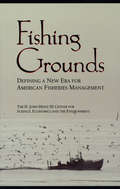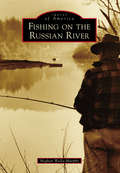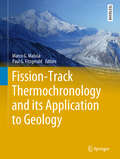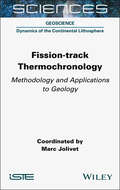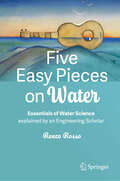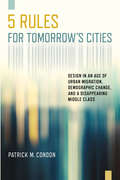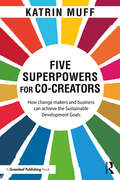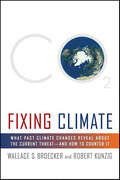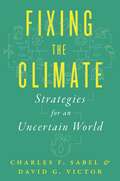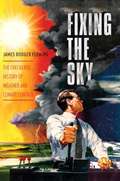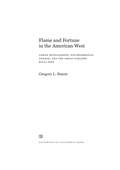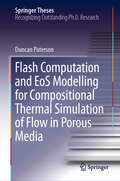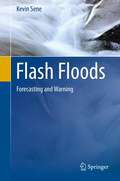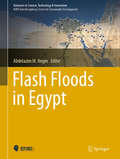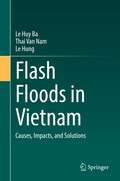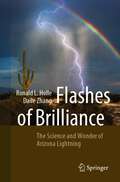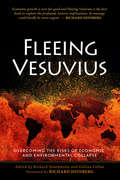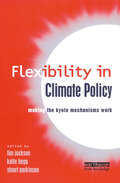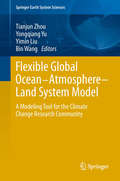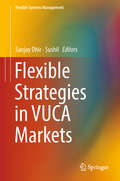- Table View
- List View
Fishing Grounds: Defining A New Era For American Fisheries Management
by Economics, and the Environment The H. John Heinz III Center for ScienceFisheries management today is highly contentious. The interests of fishers and fish processors, coastal communities, the government, and environmental organizations are often different and can even be mutually incompatible.Fishing Grounds offers a comprehensive assessment of the legal, social, economic and biological context of marine fisheries management in the United States. Drawing on interviews with stakeholders from all sides of the issue, the authors seek common ground -- and points of unresolved controversy -- among the diversity of interests and viewpoints involved. Chapters examine: history and background status of marine fisheries fishery productivity from biological, social, and economic perspectives ownership of fishery resources management structures and incentives the roles of science and evaluation Each chapter begins with legal, technical, and conceptual background to help readers understand the sets of issues involved and follows that with a balanced presentation of stakeholder views.Fishing Grounds presents a useful overview of fisheries management options and positions regarding those options, providing valuable insight into the opinions and concerns of stakeholders and the sets of incentives to which those stakeholders respond. It is an important work for fisheries management professionals in industry, government agencies, and nongovernmental organizations, as well as for students and researchers involved with fisheries and fisheries management.
Fishing in Contested Waters
by Sarah KingAfter the Supreme Court of Canada's 1999 Marshall decision recognized Mi'kmaw fishers' treaty right to fish, the fishers entered the inshore lobster fishery across Atlantic Canada. At Burnt Church/Esgenoôpetitj, New Brunswick, the Mi'kmaw fishery provoked violent confrontations with neighbours and the Canadian government. Over the next two years, boats, cottages, and a sacred grove were burned, people were shot at and beaten, boats rammed and sunk, roads barricaded, and the local wharf occupied.Based on 12 months of ethnographic field work in Burnt Church/Esgenoôpetitj, Fishing in Contested Waters explores the origins of this dispute and the beliefs and experiences that motivated the locals involved in it. Weaving the perspectives of Native and non-Native people together, Sarah J. King examines the community as a contested place, simultaneously Mi'kmaw and Canadian. Drawing on philosophy and indigenous, environmental, and religious studies, Fishing in Contested Waters demonstrates the deep roots of contemporary conflicts over rights, sovereignty, conservation, and identity.
Fishing on the Russian River (Images of America)
by Meghan Walla-MurphyThe Russian River tells a rich story of Sonoma County, both historically and ecologically. For as long as can be remembered, there has been an intimate relationship between the people of the Russian River and the fish, specifically the salmon and the steelhead. This tale of fishing begins with the Pomo people's communal fishing forays, winds through Russian exploration and early American settlement, and lands in the present time. For millennia, fishing has been a cultural cornerstone on the Russian River. Unfortunately, this once lively and productive salmonid fishery is dying. Overfishing, gravel mining, increased sedimentation from logging and agriculture, dams, and overdevelopment along the riverbanks and tributaries have all caused a decline in salmonid numbers. Thankfully, through collaborative efforts of local residents, nonprofit organizations, ranchers, farmers, and government agencies, fish populations are rebounding.
Fission-Track Thermochronology and its Application to Geology (Springer Textbooks in Earth Sciences, Geography and Environment)
by Marco G. Malusà Paul G. FitzgeraldThis book is focused on the basics of applying thermochronology to geological and tectonic problems, with the emphasis on fission-track thermochronology. It is conceived for relatively new practitioners to thermochronology, as well as scientists experienced in the various methods. The book is structured in two parts. Part I is devoted to the fundamentals of the fission-track method, to its integration with other geochronologic methods, and to the basic principles of statistics for fission-track dating and sedimentology applied to detrital thermochronology. Part I also includes the historical development of the technique and thoughts on future directions. Part II is devoted to the geological interpretation of the thermochronologic record. The thermal frame of reference and the different approaches for the interpretation of fission-track data within a geological framework of both basement and detrital studies are discussed in detail. Separate chapters demonstrate the application of fission-track thermochronology from various perspectives (e.g., tectonics, petrology, stratigraphy, hydrocarbon exploration, geomorphology), with other chapters on the application to basement rocks in orogens, passive continental margins and cratonic interiors, as well as various applications of detrital thermochronology.
Fission-track Thermochronology: Methodology and Applications to Geology (ISTE Consignment)
by Marc JolivetLow-temperature thermochronology has become an essential tool when studying near-surface geological processes. Time-temperature constraints are vital to quantify and describe a large variety of geological processes, such as relief building, erosion and sedimentation or the maturation of organic matter in sedimentary basins. After a brief history covering the discovery of fission tracks to their first applications in geochronology, Fission-track Thermochronology presents a complete description of not only the fission-track, but also the (U Th Sm)/He thermochronology approaches, both on basement rocks and on sediments. Firstly, the physical and chemical processes that underlie these techniques are addressed, and the analytical methods are described in detail. A particular focus is placed on the latest developments, such as the use of laser-ablation ICP-MS, and a whole chapter is dedicated to statistical modeling of the data. Finally, numerous examples of applications to geological questions will provide the reader with a comprehensive overview of the possibilities of low temperature thermochronology in solving geological and geomorphological questions.
Five Easy Pieces on Water: Essentials of Water Science explained by an Engineering Scholar
by Renzo RossoWater is the essential substance for life on Earth. The natural patrimony of all living beings and the material and cultural heritage, a common good, a shared resource, a treasure trove of humanity. The nature of water, water at rest and in motion, the water cycle and its management are addressed here in a multidimensional, comprehensive and transdisciplinary approach. The book focuses on water without complying with any disciplinary approach: philosophical, historical, physical and mathematical issues are merged with traditional hydrochemistry, hydrostatics, hydrodynamics and hydrology to provide an overview of basic knowledge on Earth’s water. These five lectures can be delivered to any undergraduate STEM student to introduce them a valuable, basic, multidisciplinary knowledge on water. Non-specialists will find here an insight of water made as simple as possible, but not simpler than required
Five Rules for Tomorrow's Cities: Design in an Age of Urban Migration, Demographic Change, and a Disappearing Middle Class
by Patrick M. CondonAs urban designers respond to the critical issue of climate change they must also address three cresting cultural waves: the worldwide rural-to-urban migration; the collapse of global fertility rates; and the disappearance of the middle class. In Five Rules for Tomorrow's Cities, planning and design expert Patrick Condon offers five rules to help urban designers assimilate these interconnected changes into their work: (1) See the City as a System; (2) Recognize Patterns in the Urban Environment; (3) Apply Lighter, Greener, Smarter Infrastructure; (4) Strengthen Social and Economic Urban Resilience; and (5) Adapt to Shifts in Jobs, Retail, and Wages. Five Rules for Tomorrow's Cities provides grounded and financially feasible design examples for tomorrow's sustainable cities, and the design tools needed to achieve them.
Five Superpowers for Co-Creators: How change makers and business can achieve the Sustainable Development Goals
by Katrin MuffThis groundbreaking and timely book provides change makers, organizations and facilitators with practical tools to initiate and conduct multi-stakeholder co-creation processes. Such processes are of critical importance in times of rapid change, where mega trends and grand challenges influence the market dynamics of business in entirely new ways. The book provides a concrete pathway for business to become future-ready by building capacity to work outside its traditional boundaries. The book unfolds the shift of multi-stakeholder teams from a state of competition to a state of collaboration, addressing the inner and outer dimensions of such a change. The five superpowers identified in the book are: (1) the genuine engagement of individuals, (2) collective solutions of groups, (3) transformative spaces created by facilitators, (4) the building blocks of co-creation, and (5) an effective strategy process for organizations. The book explores the challenges to achieve each of these superpowers. It also shares the stories of "heroes of transformation" and explores what have been the reasons for their success. The Sustainable Development Goals (SDGs), the grand challenges, the future of work…call it what you want, the future is here and organizations, change makers and facilitators need nothing less than these superpowers to collaborate with other players to solve these wicked problems.
Fixing Climate: What Past Climate Changes Reveal About the Current Threat—and How to Counter It
by Robert Kunzig Wallace S. BroeckerDealing with the Root Cause of Global Warming Calls for New Remedies, Says ExpertThe product of a unique collaboration between a pioneering earth scientist and an award winning science writer, FixingClimate takes an unconventional approach to the vitally important issue of global warming. Wallace S. Broecker, a longtime researcher at Columbia University's Lamont-Doherty Earth Observatory, warned about the possible consequences of global warming decades before the concept entered popular consciousness. Hooked on climate studies since his student days, he has learned, largely through his own findings, that climate changes—naturally, dramatically, and rarely benignly. He also knows from experience that when mankind pushes nature as we are currently doing by dumping some sixty to seventy million metric tons of carbon dioxide into the atmosphere every day, climate will change even more dramatically and less benignly. As Broecker points out, if a well-meaning fairy godmother were to turn us all into energysaving paragons at the stroke of midnight tonight, the resulting reduction in atmospheric carbon dioxide might lessen but could not turn aside the great warming tide now headed our way. There is, nonetheless, a glimmer of hope in the development of new technologies that are directed not only at the reduction of carbon dioxide output but also at its harmless disposal. Told by skilled science journalist Robert Kunzig, Fixing Climate is a timely and informative story that makes for riveting reading
Fixing the Climate: Strategies for an Uncertain World
by David G. Victor Charles F. SabelSolving the global climate crisis through local partnerships and experimentationGlobal climate diplomacy—from the Kyoto Protocol to the Paris Agreement—is not working. Despite decades of sustained negotiations by world leaders, the climate crisis continues to worsen. The solution is within our grasp—but we will not achieve it through top-down global treaties or grand bargains among nations.Charles Sabel and David Victor explain why the profound transformations needed for deep cuts in emissions must arise locally, with government and business working together to experiment with new technologies, quickly learn the best solutions, and spread that information globally. Sabel and Victor show how some of the most iconic successes in environmental policy were products of this experimentalist approach to problem solving, such as the Montreal Protocol on the ozone layer, the rise of electric vehicles, and Europe’s success in controlling water pollution. They argue that the Paris Agreement is at best an umbrella under which local experimentation can push the technological frontier and help societies around the world learn how to deploy the technologies and policies needed to tackle this daunting global problem.A visionary book that fundamentally reorients our thinking about the climate crisis, Fixing the Climate is a road map to institutional design that can finally lead to self-sustaining reductions in emissions that years of global diplomacy have failed to deliver.
Fixing the Sky
by Fleming James RodgerAs alarm over global warming spreads, a radical idea is gaining momentum. Forget cuts in greenhouse gas emissions, some scientists argue. Instead, bounce sunlight back into space by pumping reflective nanoparticles into the atmosphere. Launch mirrors into orbit around the Earth. Make clouds thicker and brighter to create a "planetary thermostat. "These ideas might sound like science fiction, but in fact they are part of a very old story. For more than a century, scientists, soldiers, and charlatans have tried to manipulate weather and climate, and like them, today's climate engineers wildly exaggerate what is possible. Scarcely considering the political, military, and ethical implications of managing the world's climate, these individuals hatch schemes with potential consequences that far outweigh anything their predecessors might have faced. Showing what can happen when fixing the sky becomes a dangerous experiment in pseudoscience, James Rodger Fleming traces the tragicomic history of the rainmakers, rain fakers, weather warriors, and climate engineers who have been both full of ideas and full of themselves. Weaving together stories from elite science, cutting-edge technology, and popular culture, Fleming examines issues of health and navigation in the 1830s, drought in the 1890s, aircraft safety in the 1930s, and world conflict since the 1940s. Killer hurricanes, ozone depletion, and global warming fuel the fantasies of today. Based on archival and primary research, Fleming's original story speaks to anyone who has a stake in sustaining the planet.
Flame and Fortune in the American West: Urban Development, Environmental Change, and the Great Oakland Hills Fire
by Gregory L. SimonFlame and Fortune in the American West creatively and meticulously investigates the ongoing politics, folly, and avarice shaping the production of increasingly widespread yet dangerous suburban and exurban landscapes. The 1991 Oakland Hills Tunnel Fire is used as a starting point to better understand these complex social-environmental processes. The Tunnel Fire is the most destructive fire--in terms of structures lost--in California history. More than 3,000 residential structures burned and 25 lives were lost. Although this fire occurred in Oakland and Berkeley, others like it sear through landscapes in California and the American West that have experienced urban growth and development within areas historically prone to fire. Simon skillfully blends techniques from environmental history, political ecology, and science studies to closely examine the Tunnel Fire within a broader historical and spatial context of regional economic development and natural-resource management, such as the widespread planting of eucalyptus trees as an exotic lure for homeowners and the creation of hillside neighborhoods for tax revenue--decisions that produced communities with increased vulnerability to fire. Simon demonstrates how in Oakland a drive for affluence led to a state of vulnerability for rich and poor alike that has only been exacerbated by the rebuilding of neighborhoods after the fire. Despite these troubling trends, Flame and Fortune in the American West illustrates how many popular and scientific debates on fire limit the scope and efficacy of policy responses. These risky yet profitable developments (what the author refers to as the Incendiary), as well as proposed strategies for challenging them, are discussed in the context of urbanizing areas around the American West and hold global applicability within hazard-prone areas.
Flash Computation and EoS Modelling for Compositional Thermal Simulation of Flow in Porous Media (Springer Theses)
by Duncan PatersonThis book investigates a wide range of phase equilibrium modelling and calculation problems for compositional thermal simulation. Further, it provides an effective solution for multiphase isenthalpic flash under the classical framework, and it also presents a new flash calculation framework for multiphase systems, which can handle phase equilibrium and chemical reaction equilibrium simultaneously. The framework is particularly suitable for systems with many phases and reactions. In this book, the author shows how the new framework can be generalised for different flash specifications and different independent variables. Since the flash calculation is at the heart of various types of compositional simulation, the findings presented here will promote the combination of phase equilibrium and chemical equilibrium calculations in future simulators, aiming at improving their robustness and efficiency.
Flash Floods
by Kevin SeneFlash floods typically develop in a period a few hours or less and can arise from heavy rainfall and other causes, such as dam or flood defence breaches, and ice jam breaks. The rapid development, often associated with a high debris content, can present a considerable risk to people and property. This book describes recent developments in techniques for monitoring and forecasting the development of flash floods, and providing flood warnings. Topics which are discussed include rainfall and river monitoring, nowcasting, Numerical Weather Prediction, rainfall-runoff modelling, and approaches to the dissemination of flood warnings and provision of an emergency response. The book is potentially useful on civil engineering, water resources, meteorology and hydrology courses (and for post graduate studies) but is primarily intended as a review of the topic for a wider audience.
Flash Floods in Egypt (Advances in Science, Technology & Innovation)
by Abdelazim M. NegmThis book presents the latest findings and information on flash floods in Egypt and presents case studies from various regions throughout the country. The quantitative and qualitative dimensions of these flash floods are discussed on the basis of statistical analysis and field observations. The book covers a broad and diverse range of topics, including evaluation of drainage basins, early warning systems, flash flood investigations, hydrologic simulation, GIS and flash floods, environmental flash floods, hazard management, flash flood monitoring, assessment of flood risks, flash flood vulnerability and mitigation, management of flash floods, prediction and mitigation, and rainfall harvesting and utilization. The book offers a unique source of information on virtually all dimensions of flash floods in Egypt and their environmental impacts, and combines analysis, observations, and experts’ hands-on field experience. It also supports the assessment and management of flash floods in Egypt, a country currently facing many challenges in implementing sustainable development plans, mainly because of the severe water scarcity the arid country facing.
Flash Floods in Vietnam: Causes, Impacts, and Solutions
by Le Huy Ba Thai Van Nam Le HungThis book discusses the threats and impacts of flash floods in Vietnam on environmental, human, and socio-economic resources, and covers monitoring, forecasting, warning, urgent action plans, and prevention solutions. While the work focuses on cases in Vietnam, it is applicable to many regions in the world that experience flash flooding as a common occurrence. Through data collection, field surveys, and investigational statistics from a specialized group of authors, the book provides comprehensive background knowledge on flash floods, and a flash flood hazard map using remote sensing and GIS techniques that can be used to assess the likelihood and potential impacts of flash floods before vulnerable areas and populations can be threatened. The intended audience of this manuscript is people interested in the fields of weather, environment, and natural disasters. It will serve as a reference for environmental managers, administrators of disaster planning, and extreme weather scientists.
Flash, Crash, Rumble, and Roll
by Franklyn M. BranleyExplains how and why a thunderstorm occurs and gives safety steps to follow when lightning is flashing.
Flash, Crash, Rumble, and Roll (Let's-Read-and-Find-Out Science 2)
by Dr. Franklyn M. BranleyRead and find out about what causes the flash, crash, rumble, and roll of thunderstorms in this colorfully illustrated nonfiction picture book.Did you know that lightning bolts can be over a mile long? Or that they may come from clouds that are ten miles high? Storms can be scary, but not if you know what causes them. Before the next thunderstorm, grab this book by the expert science team Franklyn Branley and True Kelley and learn all about thunderstorms.This is a clear and appealing science book for early elementary age kids, both at home and in the classroom. It's a Level 2 Let's-Read-and-Find-Out, which means the book explores more challenging concepts for children in the primary grades. The 100+ titles in this leading nonfiction series are:hands-on and visualacclaimed and trustedgreat for classroomsTop 10 reasons to love LRFOs:Entertain and educate at the same timeHave appealing, child-centered topicsDevelopmentally appropriate for emerging readersFocused; answering questions instead of using survey approachEmploy engaging picture book quality illustrationsUse simple charts and graphics to improve visual literacy skillsFeature hands-on activities to engage young scientistsMeet national science education standardsWritten/illustrated by award-winning authors/illustrators & vetted by an expert in the fieldOver 130 titles in print, meeting a wide range of kids' scientific interestsBooks in this series support the Common Core Learning Standards, Next Generation Science Standards, and the Science, Technology, Engineering, and Math (STEM) standards. Let's-Read-and-Find-Out is the winner of the American Association for the Advancement of Science/Subaru Science Books & Films Prize for Outstanding Science Series.
Flashes of Brilliance: The Science and Wonder of Arizona Lightning
by Ronald L. Holle Daile ZhangThis book is a comprehensive resource on lightning and describes the unique roles which the state of Arizona has with regard to lightning. Not only is it spectacular, it is also admired, feared, and misunderstood, but its knowledge has come of age in the last two decades.This book describes why Arizona can be called the “Lightning Photography Capital of the U.S.”, how the general public and Native Americans in Arizona have viewed lightning, and when and where lightning occurs and impacts people and resources in Arizona. It contains summaries of interviews with current and former University of Arizona staff who invented real-time lightning detection in the late 1970s and how subsequent lightning research in Arizona has been globally significant. The authors are very well acquainted with and up to date on these topics. The style of this book is active and somewhat scholarly but readable by the nonprofessional with a general interest in lightning.What is lightning? How does lightning affect Arizona? Why do photographers come to Arizona for lightning photographs? What is unique about Arizona lightning? How is lightning detected in Arizona and around the world? This book tells you answers to these questions.This book is intended for a broad audience comprised of visitors, interested lay public, a variety of scientific disciplines, media, medicine, lightning safety, and fire weather. It is suitable for readers desiring a general overview of lightning, especially in Arizona, but also for those who want to know specifically about the topic.
Fleeing Vesuvius
by Richard Heinberg Richard Douthwaite Gillian FallonPractical and fundamentally optimistic, Fleeing Vesuvius takes a hard look at many of the problems facing humanity and offers far-reaching solutions. This collection of essays by 27 leading thinkers weaves together the threads of peak oil, resource depletion, economic instability, and climate change to suggest ways of coping with a future that will be materially poorer than the past.
Flexibilisierung von Arbeitswelten in der digitalen Transformation und der Covid-19-Pandemie: Eine konfigurationstheoretische Analyse der funktionalen Umsetzung von Homeoffice (Zukunftsfähige Unternehmensführung in Forschung und Praxis)
by Madlen Anna KrügerDie Flexibilisierung von Arbeitswelten stellt eine zentrale Maßnahme für Unternehmen dar, um auf neue Anforderungen der Umwelt zu reagieren. Die Umsetzung flexibler Arbeitsmodelle muss daher wissenschaftlich erforscht und auf dieser Basis in der Praxis konkret gestaltet werden. Das vorliegende Buch untersucht empirisch die erfolgreiche Umsetzung von Homeoffice vor einem konfigurationstheoretischen Hintergrund. Es wird aufgezeigt, welche Faktoren die Umsetzung von Homeoffice in Organisationen beeinflussen, welche Konfigurationen von Faktoren in der Praxis besonders erfolgreich sind, und durch welche HR-Maßnahmen das Arbeitsmodell konkret gestaltet werden kann. Die Ergebnisse knüpfen an aktuelle Forschungen zu organisationalen Konfigurationen und zu neuen Arbeitswelten an und tragen außerdem dazu bei, künftig mehr positive Potentiale von Homeoffice nutzbar zu machen. Dazu gehören momentan besonders die Aufrechterhaltung des Arbeitsbetriebes während der Pandemie, eine leichtere Einbindung aller Arbeitskräfte in das Erwerbsleben und eine fortschreitende Gleichstellung der Geschlechter sowie ein sinkendes Verkehrsaufkommen in Zeiten des Klimawandels.
Flexibility in Global Climate Policy: Beyond Joint Implementation
by Tim Jackson Stuart ParkinsonSince the adoption of the Kyoto Protocol to the United Nations Framework Convention on Climate Change in 1997, the negotiation of policy responses to climate change has become an area of major research. This authoritative volume sets out the main debates and processes of joint implementation - bilateral or multilateral investments in greenhouse gas emission reduction or sequestration - and explores the issues involved in constructing an appropriate institutional framework. It examines the key economic, environmental, social and ethical impacts, and assesses the operational design of the flexibility mechanisms of joint implementation, including emissions trading and the Clean Development Mechanism. An approach is developed in which streamlined assessment procedures are combined with institutional safeguards in order to balance the demand for practical mechanisms with the environmental objectives of the Protocol. The book provides detailed case studies of energy sector investment in Eastern European host countries.
Flexible Global Ocean-Atmosphere-Land System Model
by Bin Wang Tianjun Zhou Yongqiang Yu Yimin LiuCoupled climate system models are of central importance for climate studies. A new model known as FGOALS ( the Flexible Global Ocean-Atmosphere-Land System model), has been developed by the Sate Key Laboratory of Numerical Modeling for Atmospheric Sciences and Geophysical Fluid Dynamics, Institute of Atmospheric Physics, Chinese Academy of Sciences (LASG/IAP, CAS), a first-tier national geophysical laboratory. It serves as a powerful tool, both for deepening our understanding of fundamental mechanisms of the climate system and for making decadal prediction and scenario projections of future climate change. "Flexible Global Ocean-Atmosphere-Land System Model: A Modeling Tool for the Climate Change Research Community" is the first book to offer systematic evaluations of this model's performance. It is comprehensive in scope, covering both developmental and application-oriented aspects of this climate system model. It also provides an outlook of future development of FGOALS and offers an overview of how to employ the model. It represents a valuable reference work for researchers and professionals working within the related areas of climate variability and change. Prof. Tianjun Zhou, Yongqiang Yu, Yimin Liu and Bin Wang work at LASG, the Institute of Atmospheric Physics, Chinese Academy of Sciences, China.
Flexible Strategies in VUCA Markets (Flexible Systems Management)
by Sushil Sanjay DhirThis book discusses the concepts of volatility, uncertainty, complexity, and ambiguity (VUCA) that are the core of various paradigms used in strategic management to understand competitive advantage as well as flexibility in organizational boundaries. It serves as a valuable reference resource in the area of VUCA markets. An increase in the levels and types of uncertainty has important implications potentially for the durability of a company’s advantages, the way firms learn and adapt, approaches for managing innovation and knowledge, and the attractiveness of different strategies and organizational models. In today’s world, strategic flexibility in VUCA is essential for business leaders to sustain market advantage and attain a clear vision amid the chaos. Business leaders who stay focused and are aware of external volatility as the prevalent characteristic are successful, while those who are not flexible in this VUCA world and lock themselves into fixed positions lose out.The book includes empirical and conceptual research papers along with case studies and models discussing strategies for emerging markets in volatile and uncertain environments. It also covers a variety of issues, including innovation, people and processes, financial management, and leadership and strategies in VUCA markets. Apart from research fraternity and academia, the contents of the book will be useful for practitioners as well as industry watchers.
Fließgewässer- und Auenentwicklung: Grundlagen und Erfahrungen
by Werner Konold Peter Meyer Stephan Von Keitz Walter Binder Mario Sommerhäuser Michael Schirmer Klaus Arzet Birgit Beckers Hubertus Brückner Holger Brux Dieter Coldewey Alexandra Dehnhardt Ulrich Detering Sebastian Döbbelt-Grüne Joachim Drüke Thomas-Ols Eggers Klaus-Dieter Fröhlich Christian Göldi Josef Groß Anja Kaussow Ellen Kiel Uwe Koenzen Annette Kurth Roland Loerbroks Helmut Mader Dietmar Mehl Thomas Paulus Tanja Pottgieser Bernd Schackers Jörg Scholle Georg Schrenk Peter Sellheim Mechtild Semrau Simon Spinner Eberhard Städtler Bernd Walser Klaus Werk Michael WeyandDieses Fachbuch erläutert die Grundlagen für die Entwicklung von Fließgewässern und Gewässerauen und hilft dabei an den Erfahrungen der Autoren teilzuhaben. Aktuelle Vorgehensweisen zum Umgang mit einer dynamischen Gewässer- und Auenentwicklung werden nachvollziehbar dargestellt und durch zahlreiche Beispiele aus unterschiedlichen Gewässerlandschaften ergänzt. Zur Erreichung der ambitionierten Ziele der Europäischen Wasserrahmenrichtlinie (WRRL) sind die gewässerökologischen, naturschutzfachlichen und hydromorphologischen Bedingungen (u.a. Hoch- und Niedrigwasser) im Gewässerkörper und in den angrenzenden Bereichen (u.a. die Gewässerauen), bei der Planung und Gestaltung zu berücksichtigen. Eine ganzheitliche Betrachtungsweise ist dabei Grundvoraussetzung.
